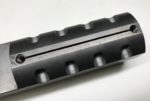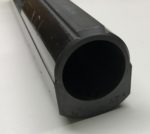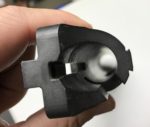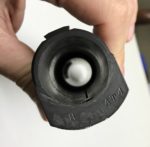Henri Canaple is a former St. Etienne and GIAT gunsmith now in private practice, who has extensive experience rebuilding and tuning FR-F1 and FR-F2 sniper rifles for the French military and competitive teams. He also designed his own precision rifle, which came close to being adopted by the French military in the late 1980s – he gave me some photos and information related to that project, which I have attached here:
M. Canaple was generous enough to share some of his time to speak to me about the history and development of French precision rifles, which I am happy to share with you today. Note that he speaks only French (which I do not), and while the interview starts out a bit choppy, we get the hang of it after a few minutes. Many thanks to Edouard L. for acting as translator for me and for providing the translated subtitles to the video!
XCL Rifle receiver photos:















Great Video Ian!
Hearing lead designers talk about their rifles is fascinating, it feels like talking to old school gunsmiths.
Any chances of having follow up in depth videos of the sigle iterations of post ww2 french precision rifles?
Which scopes/sights did they use? In the attached pdf they are shown with Anshutz diopters and S&B/Khales lenses (6×42?)
It’s such a shame the French government had let go all the competences built up over the years in its arsenals.
Best Regards,
Lorenzo
This right here is why i keep coming back Ian!
What a cool guy to interview. Keep up the awesome work gun Jesus. You are the light and the way.
Hi!
As Lorenzo, i found this interview absolutly fascinating.
As french, i had never heard about this man.
So thank you for your outstanding work.
Well done, I also thank the gentleman for his time. Was the dis-assembly of the French armory system similar to McNamara’s closing of Springfield?
The French government intended to transform separate state arsenals into a defense industry conglomerate: GIAT (Groupement des Industries de l’Armement Terrestre – Group or Land Weapon Industries).
I am not sure if, at that time, it was meant to become a private group or stay in public control. But it was an issue of cost and European lead.
When FN was purchased, it was to be the small arms pole for GIAT, so the other small arms plants (and ammo) were closed.
When in need of cash, GIAT resold FN they lost their small arms capabilities.
That is sound explanation why France lost small arms capability; it makes sense.
“GIAT”
I know that they were working on project ADR (ADR GIAT), short info and one photo might be found here:
http://securityarms.com/20010315/galleryfiles/3300/3396.htm
It was designed for own 5.7 mm cartridge, similar to 5.7×28 used in FN P90 or 4.6×30 used in H&K MP7. It was abandoned in favor of FN P90. Interesting feature of this weapon was it triggers (see photo).
Another fascinating episode about an obscure weapon and doubly fascinating because it is bilingual.
Bi-lingualism – or tri-lingualism – can open up enormous opportunities. Did I even tell you about my experiences at the West Sherman Army paratrooper school …..?
Great interview!
The FN precision rifle that M. Canaple refers to as being developed in the 1990s is probably the FNH PBR/SPR/TSR. These were developed around the then re-introduced “Pre-64” Winchester Model 70 action, with so called “controlled round feed.” FNH owns these designs.
The Browning BAR, (sporting version), based precision rifle that Edouard L. mentions is probably the FN FNAR that was developed in the early 2000s.
I also enjoyed the mention of the “squeeze bore” technique to get around the problem of barrel erosion in precision rifles. That along with his mentioning that he was skeptical of barrel tuners at the beginning of the video reminds me of the bull sessions that people get into at the range when discussing precision rifle construction. ^__^
Well this “conical” bore is more like choked barrel as often seen on air guns than a true squeeze bore.
In fact, you will get this condition on hammer forged barrel after profiling because residual stresses tend to contract the bore where less material is remaining: that being at the muzzle.
Button rifle barrels tend to go the other way, residual stresses tend to expand the barrel at the muzzle: not good for accuracy.
I am just at beginning of interview, but must differ from what Mr.Canaple says. I am not sure if Mle 49/56 was not furnished that way, but I know that FAL was; the cartridge head seat WAS tilted to accommodate geometry of locked position for bolt. It would be serious omission, if it was not.
Better term would be “accommodating tilt of bolt” in locked position. Yes, it takes some fancy machining which is part of the concept.
https://s-media-cache-ak0.pinimg.com/originals/45/5a/f4/455af4698231697889a2394f97f59906.jpg
A rotary bolt action does not need any of that.
Main problem for the FAL as a sniper was the wobbly receiver cover used to mount the scope. And the 2 parts receiver with the bolt locking in the lower whereas the barrel in the upper did not help.
Yes, that adds up, something akin AK type rifles.
Actually, bolt group locks into machined upper (locking insert), which is firmly connected to barrel. The lower group (stamping) which connects with butt, attaches to top assembly via removable pin (see illustration). But overall I agree, FAL does not make the best sniper rifle.
On lost wax made receivers; I recall that material such as carburized SAE 8620, used for cast steel parts will not have any worse strength then similarly treated SAE 4130/ 4140 – considering French/ EU equivalents. To produce locking lugs into cast metal surface with requested accuracy is merely impossible, therefore I do not see where the saving would be.
Further on subject of helical locking lugs; we had encounters with them in past on FW at several weapons and they are good not just to produce consistent and adoptable obturation, but mainly they are instrumental for positive and smooth extraction. I believe they were used as early as the end of 19 century so machinery was available already then.
Cz and Brno pioneered the use of investment casting key strength parts, such as receivers. Ruger was close behind.
The advantage is that only a light finishing cut is needed on surfaces where dimensions are critical, rather than having to make big heavy cuts to remove stock, in the case of manufacture from forgings and bar stock.
Hot isostatic pressing of raw castings (using fluid pressure rather than dies) serves to close up small internal voids, but, appart for the use of directional crystallization of the casting, there is no way to align the fabric of the metal,
Aligning the fabric of the metal to orientate flaws into the least harmful direction, still requires forging.
Interestingly, the metals that tend to machine well, don’t like to be cast. The Mn sulphide stringers or blebs of lead that give rise to good machining characteristics,tend to segregate.
I really enjoyed this video, and I’m glad I came here to see the pictures of the receiver of the XCL. Out of curiosity, was there any footage you didn’t include in this video because it was too choppy, or because it made the video too long?
Whoever the man is who did the translation: bloody well done that man! If he had been speaking in english I would not have remembered half of what he said, let alone be able to repeat it in another language!
I have to say though, Iain is a kind of honest bloke who honest people like, and then like to help.
Here is some (presumably) professional deployment of FR F2 rifle:
https://www.youtube.com/watch?v=SfBEJBemmj0
Pas – hit!
He said “bas” => low
Videos like this is why I check on this site every day.
Merci beaucoup.
This is the first time I’ve visited this page. i watch your videos regularly. This is an absolutly amazing video.I’m going to have to check out this page more often. Thanks Ian.
The barrel wear described might be solved by progressive rifling. Wartime work by Mauser showed a 50% increase in machine gun barrel wear.This happened because the barrel heated up equally over it`s length
Maybe, but the manufacturing price/barrel life is higher than a non-progressive rifled barrel.
Thank you for making this video Ian. My dad had much more to offer in regard of other historical guns making than just the FRF1 or FRF2. Maybe one day you and him will have the chance again to share this knowledge.
Good job!!
Dear Mr. Canaple. Is there a manual for the XCL rifle that you could share?
Whats up are using WordPress for your site platform?
I’m new to the blog world but I’m trying to get started and create my own.
Do you need any html coding knowledge to make your own blog?
Any help would be really appreciated!